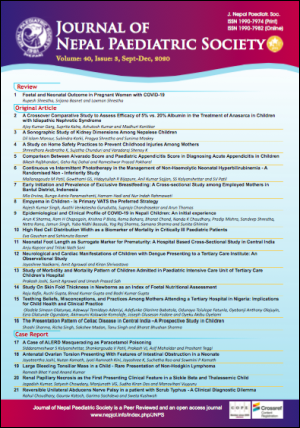Teething Beliefs, Misconceptions, and Practices Among Mothers Attending a Tertiary Hospital in Nigeria: Implications for Child Health and Clinical Practice
DOI:
https://doi.org/10.3126/jnps.v40i3.30008Keywords:
Beliefs, Harmful practices, Misconceptions, Mothers, Teething, NigeriaAbstract
Introduction: Teething is a physiologic process that begins during infancy. However, some mothers often attribute certain symptoms to teething. In this study, we assessed the opinions and practices of mothers attending a tertiary health facility in Nigeria on teething.
Methods: This was a cross-sectional, descriptive study conducted among caregivers of children presenting to the out-patient department of a tertiary hospital, Southwestern Nigeria.
Results: Five hundred and sixteen mothers were studied. The leading symptoms attributed to teething were fever 420 (81.4%), reduced food intake / appetite 320 (62.0%), diarrhoea 314 (60.9%) and vomiting 294 (57.0%). Some believed that teething is associated with convulsion 102 (19.8%), mouth ulcers 69 (13.4%), ear discharge 68 (13.2%), and no symptoms 41 (7.9%). Majority of the mothers 374 (72.5%) believed that teething requires treatment. Two hundred and four (39.5%) mothers had given their children oral analgesics for teething while 194 (37.6%) administered teething mixtures. These medications were more likely to be prescribed at the hospital or purchased over the counter (p < 0.05). Other treatments given included herbal concoction 46 (8.9%), local tooth extraction 22 (4.3%), enema 17 (3.3%), body scarifications 14 (2.7%), gum fomentation 14 (2.7%) and gum incision 12 (2.3%). Responders who attributed convulsion to teething were more likely to have incised their children’s gums (p < 0.05).
Conclusions: This study revealed that sundry symptoms were attributed to teething and harmful home interventions were done for teething. There is a need to educate the society on teething and discourage harmful practices for teething by caregivers.
Downloads
Downloads
Published
How to Cite
Issue
Section
License
Authors who publish with this journal agree to the following terms:
Authors retain copyright and grant the journal right of first publication with the work simultaneously licensed under a Creative Commons Attribution License that allows others to share the work with an acknowledgement of the work's authorship and initial publication in this journal.
Authors are able to enter into separate, additional contractual arrangements for the non-exclusive distribution of the journal's published version of the work (e.g., post it to an institutional repository or publish it in a book), with an acknowledgement of its initial publication in this journal.
Authors are permitted and encouraged to post their work online (e.g., in institutional repositories or on their website) prior to and during the submission process, as it can lead to productive exchanges, as well as earlier and greater citation of published work (See The Effect of Open Access).



